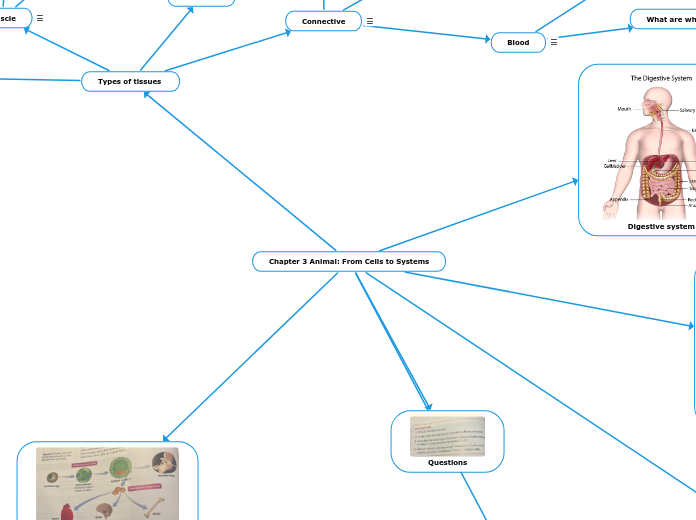Chapter 3 Animal: From Cells to Systems
Types of tissues
Epithelial
James:-Makes lines to the surfaces of the body, both as a body covering and between internal organs]-Made of cells with a strong connection with between cell membranes, so they form a barrier
Skin epithelia
James:-Made of thin/flat cells that form sheets and act as a semi-permeable barrier between the inside/outside of the body
Columnar epithelia
James:Made of columns of cells that line the small intestine, the stomach and glands-May secrete mucus, have finger-like projections called cilia and absorb materials
Muscle
James: -Designed to change their shape-Act by shortening or lengthning
Skeletal muscle
James:-Made of cells that line up in the same direction -Attaches to bone, making, so the body can move -It's found in the limbs, like arms and legs, and places. Where the body needs support, such as around the lower abdomen and back -
Smooth muscle
James:-Made of cells that are reduced at both ends and do not have striated appearance -It's found in blood vessels and the walls of internal organs like the esophagus and stomach-It contracts more slowly than skeletal muscle, but it's action can be sustained for a longtime
Cardiac muscle^
James: -Made of cells whose nuclei sometimes appear to be between cells -Are branched and unevenly striated -Contracts as a unit-Found only in the heartAkira: Cardiac muscle (or myocardium) makes up the thick middle layer of the heart. It is one of three types of muscle in the body, along with skeletal and smooth muscle.
Nervous
James:-Made of cells called neurons which have finger-like projection to receive and transfer signals-coordinates body movement
Actions
James:Are varied in their actions:-some relay signals from the brain or spinal cord to muscles and glandsothers detect information from their environment and trigger the body's responses
Connective
James:-Strengths,supports, protects, binds, or connects cells and tissues-Consists of cells in an extracellular matrix that can range from a liquid(in blood), to elastic materials that can stretch in ligaments to mineral deposits(in bone).
Bone
James: -Made of cells surrounded by calciun-hardened tissue through which blood vessels run-Needed for movement, support, protection
Fat(adipose tissue)
Akira: Adipose tissue, otherwise known as body fat, is a connective tissue that extends throughout your body. found under your skinbetween your internal organsJames:-Made of large, tightly packed cells-Found under the skin and around organs -Needed for energy storage padding and insulation
Blood
James:-Includes red blood cells, white blood cellls, and platelets within a straw-coloured liquid matrix called plasma -Transports nutrients and oxygen-Clots when the skin is cut -Attacks invaders such as bacteria and viruses
What are red blood cells?
Akira: A type of blood cell that is made in the bone marrow and found in the blood. Red blood cells contain a protein called hemoglobin, which carries oxygen from the lungs to all parts of the body.
What are white blood cells
Akira: White blood cells are part of the body's immune system. They help the body fight infection and other diseases.
Questions
Main topic
Digestive system
respiratory system
Akira: The lungs and respiratory system allow us to breathe. They bring oxygen into our bodies (called inspiration, or inhalation) and send carbon dioxide out (called expiration, or exhalation)James(Information from slides):Exchanges gases between the body and the environmentBrings oxygen (O2) into the body Releases carbon dioxide (CO2) from the body
Circulatory system
Akira: The circulatory system is made up of blood vessels that carry blood away from and towards the heart. Arteries carry blood away from the heart and veins carry blood back to the heart.James(information from slides)Transports gases around the body via red blood cellsOxygen (O2)Carbon dioxide (CO2) Transports nutrients to body partsTransports waste to organs responsible for removing them from the body
Excretory system
Akira: The function of the excretory system to remove wastes from the body. These wastes include water, CO2, nitrogen, salts, and heat.James(Information from slides):Removes liquid wastes from the bodyKidneys filter blood to remove wastes from itBladder stores urine until it collects enough to be excreted
